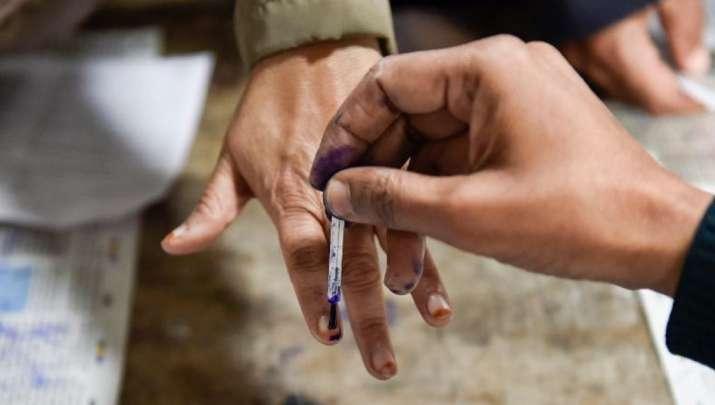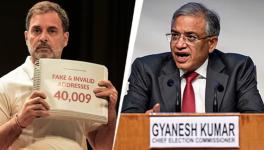Index of Opposition Unity May be the X-factor in Goa Polls

Image for representational purpose. Credit: India TV News
An interesting oddity of the first-past-the-post (FPTP) electoral system that India opted for, is that in a multiparty system like India, to win an election one need not win the popular vote or majority of the votes polled. All a candidate needs to ensure is that he or she gets more votes than the closest competitor. Simply put, to win, one need not secure 50% of the votes polled. One can even win by securing 25% to 30% of votes polled, if that is all that is needed to beat the second placed competitor.
Consequently, in the first-past-the-post system that India inherited from its British colonists, the easiest way to win an election is to follow the British policy of ‘Divide Et Impera’. The rationale behind this ‘Divide and Rule’ approach is simple – it is easier to win an election by splitting your opponent’s votes than by capturing the additional votes required to win the popular vote. In simple terms, the more the opposition is divided, the fewer votes are needed to win.
An analysis by Prannoy Roy and Dorab Sopariwala in their book The Verdict: Decoding India’s Elections reveals that over the years, the average minimum vote percentage required to win an Assembly election in India i.e. the winning threshold has been rapidly falling. In the most recent phase, starting from 2002, the average vote percentage required to win has dropped to 40%. The coastal state of Goa, which will vote on February 14, has been an outlier. Between 2002-2017, in four Assembly polls, it witnessed an average winning threshold of 35% – much lower than the national average. In the most recent assembly election in 2017, the Congress won 17 seats, emerging as the single largest party, with a vote share of just 28.4%.
Table ‘A’ Vote percentage needed to win state assembly elections has declined over time.
|
Years |
Average votes of the winning party/alliance in seats contested. |
|
1952-1977 |
44% |
|
1977-2002 |
43% |
|
2002 onwards |
40% |
Source: The Verdict: Decoding India’s Elections.
Roy and Sopariwala link this phenomenon of dramatically falling winning threshold to the fall in the ‘Index of Opposition Unity’. Over the years, as the opposition became more fragmented, the IOU fell leading to a sharp fall in the average minimum vote percentage required to win an election at the state level. Prannoy Roy and Ashok Kumar Lahiri developed the Index of Opposition Unity (IOU) in the 1980s to study the unity and disunity among Opposition parties and the expected ramifications of the changing patterns of opposition unity or disunity.
It is to be noted that the IOU is a definition and not an equation. The IOU which ranges from 0 to 100 is:
Vote (%) of the largest Opposition party
IOU= -------------------------------------------------------------- x 100
Sum of the votes (%) of all Opposition parties
The IOU works not just for the ruling party or alliance, but for whichever is the dominant electoral force in a state or region. The IOU, as stated earlier can vary from 0 to 100, with 100 implying that there is only one Opposition party i.e. bi-party system. As the IOU falls down more and more, it signifies an increasingly divided or splintered Opposition.
Between 1952-1977, the average IOU (data analysed for 78 Assembly polls in big and medium-sized states) was 69. In the most recent phase (2002-2019) of India’s elections, the average IOU has fallen to 64.
Table ‘B’ The Opposition has become more fragmented in Assembly elections over the years.
|
Years |
Average IOU |
|
1952-1977 |
69 |
|
1977-2002 |
67 |
|
2002 onwards |
64 |
Source: The Verdict: Decoding India’s Elections.
Once again the state of Goa stands out. The existence of various regional outfits in Goa has meant that the state’s IOU has been much lower than the national IOU. In the 2017 elections, the IOU against the BJP was just 43 – way below the national average of 64 during the same phase. The IOU against the BJP was higher in 2012 at 59. The IOU dropped from 59 to 43 in 2017 due to the emergence of new anti-BJP forces on Goa’s political landscape – the Vijai Sardesai-led Goa Forward Party and the Aam Aadmi Party. The Maharashtrawadi Gomantak quit the NDA and the NCP quit the Congress alliance in 2017. This led to a further split of anti-BJP votes, lowering the IOU.
The most significant ramification of a falling IOU is that seats are now being won not because of winning the popular vote but by dividing the opposition. From 2002 onwards, 45% of seats were won due to a low IOU.
Table ‘C’ A comparison of victories due to high popular vote v/s victories due to a low IOU i.e divided opposition.
|
Years |
Percentage of seats won due to a low IOU |
Percentage of seats won due to a high popular vote |
|
1952-1977 |
36% |
64% |
|
1977-2002 |
31% |
69% |
|
2002- |
45% |
55% |
Source: The Verdict: Decoding India’s Elections.
In Goa, the proportion of seats won due to a low IOU is even higher. In the 2017 elections, 60% of seats were won due to a low IOU- significantly higher than the national average during the same period. The low IOU disproportionately helped the BJP.
Table ‘D’ Analysing the BJP’s victories in the 2017 Assembly elections.
|
Percentage of seats won due to a low IOU |
Percentage of seats won due to a high popular vote |
|
70% |
30% |
Seventy percent of the seats won by the BJP in 2017 were won with a vote-share of less than 50%. These victories can be directly attributed to a low Index of Opposition Unity against the BJP. In other words, a weakened, splintered opposition helped the BJP win these seats. As mentioned earlier, the IOU against the BJP was low due to the entry of new anti-BJP forces and realignment of existing political forces like the Maharashtrawadi Gomantak and the Nationalist Congress Party. Had the opposition prevented the split of votes, ensuring a higher IOU against the BJP, the saffron party would have struggled to even cross single digits in the 2017 elections.
With no grand alliance against the ruling BJP, the coastal state is all set to witness a quadrangular fight between the Congress-Goa Forward Party alliance, the BJP, the TMC-Maharashtrawadi Gomantak alliance and the Aam Aadmi Party. While the absence of a rainbow coalition and the multi cornered contest leading to a possible split in the opposition votes, gives an edge to the BJP, the saffron party is facing heavy anti-incumbency in the state. Cutting across caste and religious divide, there appears to be a deep sense of anger against the ruling dispensation. Growing unemployment, rising prices of essentials, charges of corruption against ministers, the government’s inept handling of the coronavirus crisis have all contributed to the growing sense of anti-incumbency. In recent years, mass protests led by citizen groups and civil society members have also pushed the saffron party’s government on the backfoot. The Pramod Sawant government was on a sticky wicket during the mass protests against the illegal construction of a bungalow belonging to the spouse of a Mumbai-based BJP spokesperson and also against government projects like the South Western Railway’s double tracking project and the proposed IIT-Goa project at Melauli. Another embarrassing fiasco for the ruling dispensation has been the alleged Public Works Department (PWD) jobs scam. What made the entire episode even more embarrassing for the BJP government was that the allegations against the then PWD minister Deepak Pauskar were levelled by fellow partman and BJP MLA Atanasio Monserrate.
It is worth recollecting that even in the 2017 elections the BJP had faced heavy anti-incumbency. The saffron party’s tally had fallen from 21 to 13- eight short of the majority mark in the 40-member Goa assembly. However, the party was able to beat the Congress which had emerged as the single largest party with 17 seats in the race to form the government. The BJP’s act of coming to power through the backdoor has also aggravated its anti-incumbency woes. The Goan voter has not forgotten or forgiven the BJP for what it did in 2017.
There are many similarities between 2017 and 2022. Just like 2017, there is a strong sentiment of anti-incumbency against the ruling government. In 2017, the emergence of new anti-BJP players and a historically low IOU of 43 against the party of Goa’s political scene had turned out to be a blessing in disguise for the Bharatiya Janata Party. In 2022, several factors like the emergence of another new anti-BJP force- the Trinamool Congress in Goa and the rising stocks of the AAP in the state, the decision of Shiv Sena and NCP to forge an anti-BJP alliance are likely to split the anti-BJP vote, lowering the IOU against the BJP even more. The 2017 scenario of BJP benefitting disproportionately due to a splintered opposition seems highly likely. One positive for the BJP’s arch rival, Congress is that it has been able to enter into a pre-poll alliance with the Goa Forward Party which had secured a vote share of 3.5% in the 2017 elections. Another X-factor in the elections could be new entrant Revolutionary Goans. The party is banking on the son of the soils card and has promised 100% reservation in government jobs for Goans. The newly floated outfit is gaining some traction among the youth- especially in the Hindu-majority areas. If the party makes a decent debut, it could also dent the BJP by cutting its traditional vote-especially in North Goa.
In recent times, the BJP has benefited due to a low IOU against it. Another recent example is the Assam assembly election. Though the Congress forged a rainbow coalition of anti-BJP forces in Assam, the split in opposition votes and the low IOU against the BJP in the Upper Assam region- a result of Raijor Dal-Assam Jatiya Parishad alliance's decision to go solo helped the BJP to retain power. A simple post poll analysis of the results shows that had the Raijor Dal-AJP accepted the Congress party’s offer to join the grand alliance, the alliance would have won a simple majority of 65 seats. Will the Assam scenario repeat in Goa? The answer will be known only when the votes are counted on March 10.
The author is a freelancer based in Bombay and an alumnus of Mumbai’s St. Xavier’s College. His interests vary from politics, psephology, and journalism to regional Indian cinema. He tweets @Omkarismunlimit
Get the latest reports & analysis with people's perspective on Protests, movements & deep analytical videos, discussions of the current affairs in your Telegram app. Subscribe to NewsClick's Telegram channel & get Real-Time updates on stories, as they get published on our website.
























